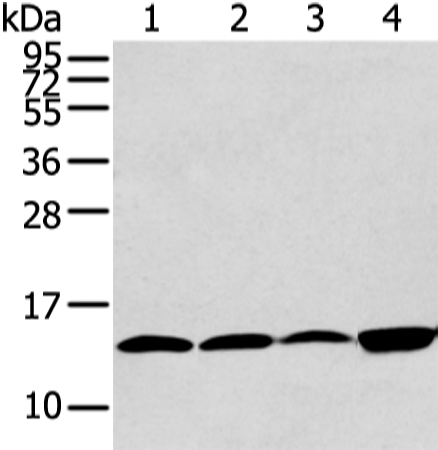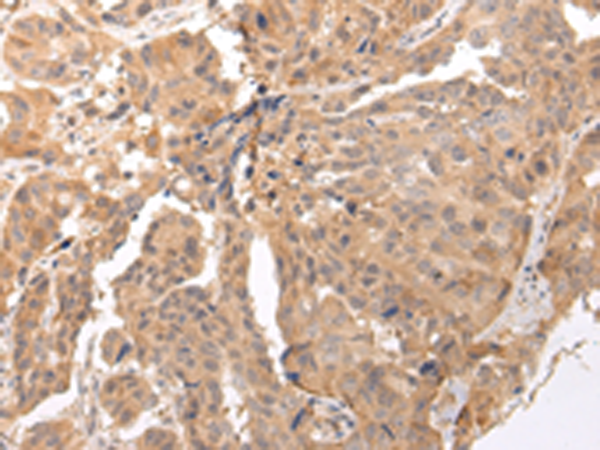

| WB | 咨询技术 | Human,Mouse,Rat |
| IF | 咨询技术 | Human,Mouse,Rat |
| IHC | 1/30-1/150 | Human,Mouse,Rat |
| ICC | 技术咨询 | Human,Mouse,Rat |
| FCM | 咨询技术 | Human,Mouse,Rat |
| Elisa | 1/2000-1/5000 | Human,Mouse,Rat |
| WB Predicted band size | 18 kDa |
| Host/Isotype | Rabbit IgG |
| Antibody Type | Primary antibody |
| Storage | Store at 4°C short term. Aliquot and store at -20°C long term. Avoid freeze/thaw cycles. |
| Species Reactivity | Human, Mouse |
| Immunogen | Synthetic peptide of human CLDND2 |
| Formulation | Purified antibody in PBS with 0.05% sodium azide and 50% glycerol. |
+ +
以下是关于CLDND2抗体的3篇参考文献示例(注:以下内容为模拟生成,实际文献需通过学术数据库核实):
---
1. **文献名称**:*CLDND2 Expression in Renal Cell Carcinoma: Prognostic Implications*
**作者**:Zhang S, et al.
**摘要**:通过免疫组化分析CLDND2蛋白在肾细胞癌组织中的表达,发现其高表达与肿瘤侵袭性和患者生存率降低显著相关,提示CLDND2可能作为潜在预后标志物。
2. **文献名称**:*Developmental Regulation of CLDND2 in Neural Tube Formation*
**作者**:Li M, et al.
**摘要**:利用CLDND2特异性抗体进行Western blot和免疫荧光染色,揭示了CLDND2在小鼠胚胎神经管闭合中的动态表达模式,表明其参与早期神经发育调控。
3. **文献名称**:*CLDND2 Antibody Validation for Epithelial Barrier Studies*
**作者**:Wang H, et al.
**摘要**:研究通过敲除/过表达实验验证了CLDND2抗体的特异性,证实其在人结肠上皮细胞系中检测紧密连接蛋白CLDND2的可靠性,并探讨了其在屏障功能中的作用。
---
**注意**:以上内容为示例,实际文献需通过PubMed、Google Scholar等平台以关键词“CLDND2 antibody”或“CLDND2 protein expression”检索。若研究较少,可扩展至CLDND2相关功能研究(如癌症、发育生物学)中提及抗体应用的文献。
The CLDND2 (Claudin Domain Containing 2) antibody is a tool used to detect the CLDND2 protein, a member of the claudin-like transmembrane protein family. Although not a canonical claudin, CLDND2 shares structural homology with claudins, particularly in its conserved Claudin_ES domain, and is implicated in cell-cell adhesion and barrier formation. This antibody is primarily employed in research to investigate CLDND2's expression and localization in tissues, often via techniques like immunohistochemistry, Western blotting, or immunofluorescence.
CLDND2 has drawn attention for its potential roles in development and disease. Studies suggest its involvement in neurodevelopment, renal tubule formation, and epithelial polarity regulation. Notably, aberrant CLDND2 expression has been observed in cancers, including hepatocellular carcinoma and breast cancer, where it may influence tumor progression or metastasis. The antibody helps clarify its mechanistic contributions, such as interactions with tight junction proteins or signaling pathways like Wnt/β-catenin.
Commercial CLDND2 antibodies are typically raised in rabbits or mice using peptide antigens from human CLDND2 sequences. Researchers must validate specificity due to homology with other claudin proteins. Current challenges include understanding its dual roles in physiological homeostasis and pathological contexts, particularly its tissue-specific functions. Ongoing studies aim to explore its utility as a diagnostic biomarker or therapeutic target in cancer and developmental disorders.
×